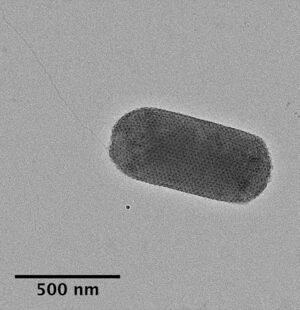Nitrosarchaeum limnium: Difference between revisions
| Line 28: | Line 28: | ||
==Ecology and Environment== | ==Ecology and Environment== | ||
<i>N. limnium</i> was first enriched from the San Francisco Bay estuary, and has been found in numerous low-salinity environments worldwide including rivers, lakes, aquifers, and soils. It is free-living and motile, allowing for response to environmental signals and interactions with other microorganisms within aquatic communities.<br> | |||
In such communities, the ammonia oxidized by <i>N. limnium</i> to nitrite is then available for other microorganisms to take up as a nitrogen source (e.g., phytoplankton) or use in other portions of the nitrogen cycle. This includes nitrite oxidation, which is performed by different guilds of bacteria such as <i>Nitrospira</i>, <i>Nitrospina</i>, <i>Nitrococcus</i>, and <i>Nitrobacter</i>. In systems where anoxic regions border oxic regions (water/sediment interfaces in estuaries, for example), nitrite produced by this organism could also be used as a substrate for anaerobic nitrogen cycle processes including denitrification and anammox.<br> | |||
As ammonia oxidation is the first and rate limiting step of nitrification, it plays an important role in the nitrogen cycle the environment and thus <i>N. limnium</i> is an important contributor to nitrogen biogeochemistry in low-salinity environments.<br> | |||
==References== | ==References== | ||
Revision as of 19:16, 23 August 2022
Classification
Archaea; Thaumarchaeota; Nitrososphaeria; Nitrosopumilales; Nitrosopumilaceae
Species
|
NCBI: [1] |
Candidatus Nitrosarchaeum limnium
Description and Significance
Nitrosarchaeum limnium (formerly Nitrosoarchaeum limnia) is a member of the low-salinity ammonia-oxidizing archaea (AOA), first enriched from sediments in north San Francisco Bay estuary, CA, USA (Blainey et al., 2011; Mosier et al., 2012).
As a member of the ammonia-oxidizing archaea (AOA), N. limnium grows using energy obtained from the oxidation of ammonia (NH4+) to nitrite (NO2-), the first step in nitrification. This process is a critical step in the global nitrogen cycle, as buildup of ammonia in environments can lead to eutrophication and other consequences.
Genome Structure
Describe the size and content of the genome. How many chromosomes? Circular or linear? Other interesting features? What is known about its sequence?
Cell Structure, Metabolism and Life Cycle
Interesting features of cell structure; how it gains energy; what important molecules it produces.
Ecology and Environment
N. limnium was first enriched from the San Francisco Bay estuary, and has been found in numerous low-salinity environments worldwide including rivers, lakes, aquifers, and soils. It is free-living and motile, allowing for response to environmental signals and interactions with other microorganisms within aquatic communities.
In such communities, the ammonia oxidized by N. limnium to nitrite is then available for other microorganisms to take up as a nitrogen source (e.g., phytoplankton) or use in other portions of the nitrogen cycle. This includes nitrite oxidation, which is performed by different guilds of bacteria such as Nitrospira, Nitrospina, Nitrococcus, and Nitrobacter. In systems where anoxic regions border oxic regions (water/sediment interfaces in estuaries, for example), nitrite produced by this organism could also be used as a substrate for anaerobic nitrogen cycle processes including denitrification and anammox.
As ammonia oxidation is the first and rate limiting step of nitrification, it plays an important role in the nitrogen cycle the environment and thus N. limnium is an important contributor to nitrogen biogeochemistry in low-salinity environments.
References
Blainey PC, Mosier AC, Potanina A, Francis CA, & Quake SR (2011) Genome of a low-salinity ammonia-oxidizing archaeon determined by single-cell and metagenomic analysis. PLoS One 6: e16626. https://doi.org/10.1371/journal.pone.0016626
Mosier AC, Lund MB, & Francis CA (2012) Ecophysiology of an ammonia-oxidizing archaeon adapted to low-salinity habitats. Environ Microbiol 64: 955–963. https://doi.org/10.1007/s00248-012-0075-1
Tolar BB, Mosier AC, Lund MB, & Francis CA (2019) Nitrosarchaeum (gbm01289). In: Bergey’s Manual of Systematics of Archaea and Bacteria, Ed: WB Whitman, John Wiley & Sons: Hoboken, NJ. https://doi.org/10.1002/9781118960608.gbm01289
Author
Page authored by Prof. Bradley Tolar at UNC Wilmington.

